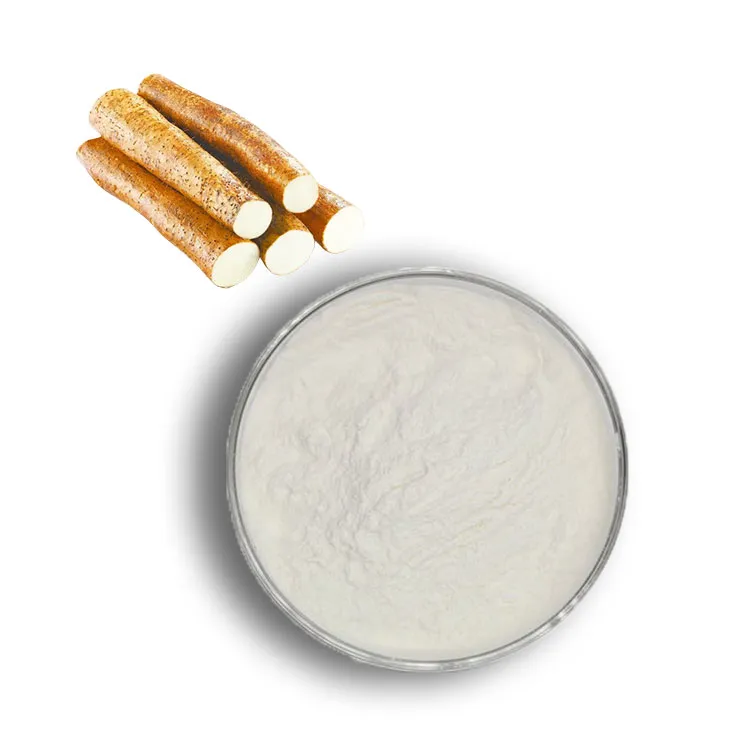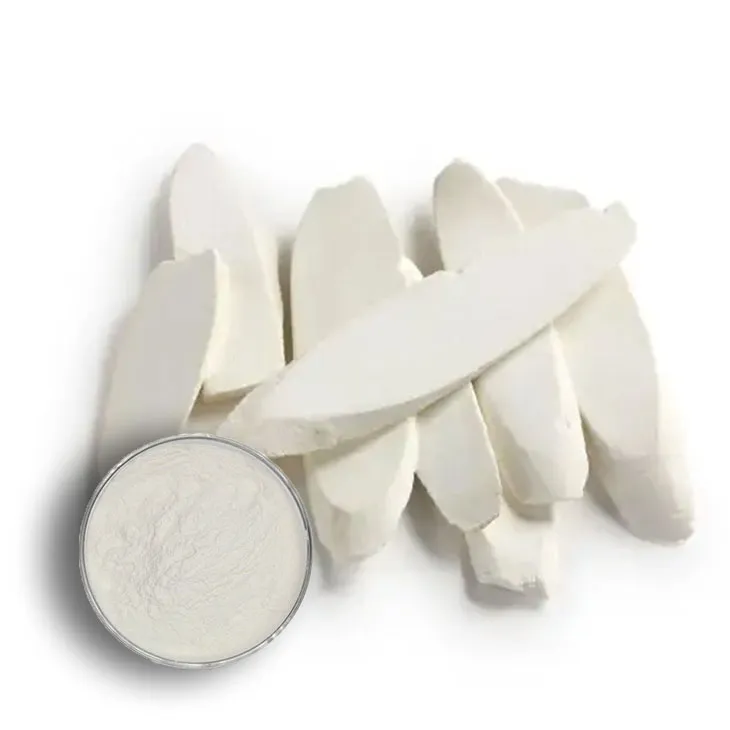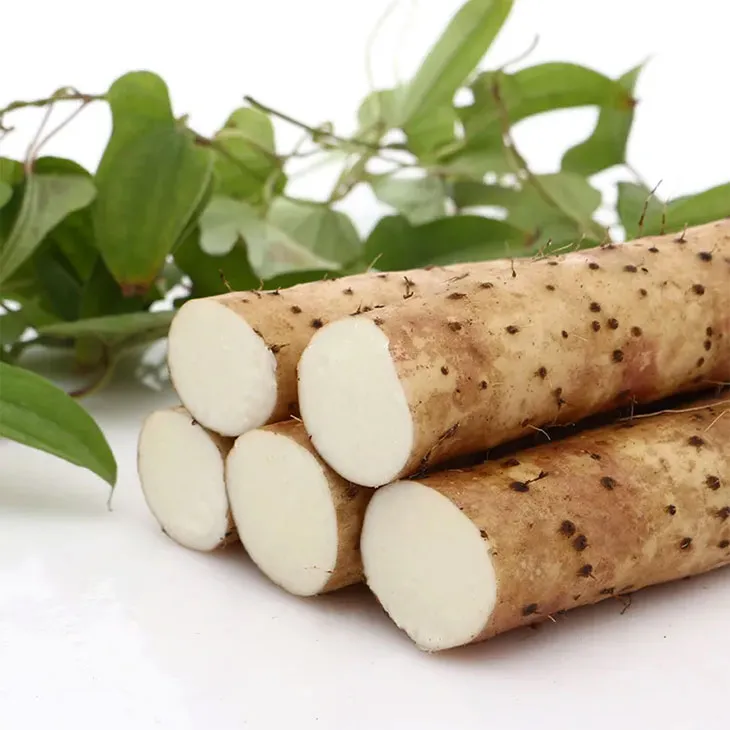- 0086-571-85302990
- sales@greenskybio.com
The process of extracting yam mucin from yam extract.
2024-11-28

1. Introduction
Yam, a widely consumed tuber, has been recognized for its various beneficial properties. Yam mucin, a key component of Yam Extract, has significant potential in the fields of medicine and food. The extraction process of yam mucin from Yam Extract is of great importance as it can lead to the production of high - quality mucin for diverse applications.

2. Pretreatment of Yam Extract
2.1 Selection and Cleaning of Yams
The first step in obtaining yam extract for mucin extraction is the careful selection and cleaning of yams. High - quality yams should be chosen, free from any signs of rot or disease. These yams are then thoroughly washed to remove dirt, soil, and other impurities. This is crucial as any contaminants can interfere with the subsequent extraction process and affect the quality of the resulting yam mucin.
2.2 Peeling and Slicing
Once the yams are clean, they are peeled to remove the outer skin, which may contain unwanted substances. After peeling, the yams are sliced into small, uniform pieces. This increases the surface area of the yam, facilitating better extraction during the subsequent steps. Uniform slicing also ensures that all parts of the yam are exposed to the extraction agents evenly.
2.3 Blanching
Blanching is an important pretreatment step. The sliced yams are briefly immersed in hot water or steam. This process serves multiple purposes. Firstly, it helps to inactivate enzymes present in the yam that could potentially degrade the mucin during extraction. Secondly, it can further clean the yam pieces by removing any remaining surface contaminants. The blanching time and temperature need to be carefully controlled. If the time is too long or the temperature too high, it may lead to the loss of some valuable components in the yam, including mucin precursors.

3. Extraction Mechanisms
3.1 Solvent Extraction
Solvent extraction is a commonly used method for extracting yam mucin from the pretreated yam extract. A suitable solvent needs to be selected. Water is often a primary choice as it is a natural and safe solvent. However, in some cases, a combination of water and other solvents such as ethanol may be used. The yam slices are immersed in the solvent, and the mixture is stirred gently. This allows the mucin to dissolve into the solvent. The extraction time and temperature play a crucial role. For example, a longer extraction time at an appropriate temperature can increase the yield of mucin. But if the temperature is too high, it may cause denaturation of the mucin, reducing its quality.
3.2 Enzyme - Assisted Extraction
Enzyme - assisted extraction is another approach. Specific enzymes can be added to the yam extract to break down the cell walls and release the mucin more effectively. For instance, cellulase and pectinase can be used. These enzymes target the polysaccharide components of the yam cell walls. By hydrolyzing these components, they create pores and channels in the cell walls, allowing the mucin to be more easily extracted. However, the enzyme concentration, reaction time, and pH need to be carefully optimized. Incorrect enzyme concentration may lead to incomplete extraction or excessive degradation of the yam tissue, while improper reaction time or pH can also affect the extraction efficiency and the quality of the mucin.
3.3 Ultra - sonic Assisted Extraction
Ultra - sonic assisted extraction utilizes ultrasonic waves to enhance the extraction process. The ultrasonic waves create cavitation bubbles in the solvent - yam extract mixture. When these bubbles collapse, they generate intense local forces that can break open the yam cells and release the mucin. This method can significantly reduce the extraction time compared to traditional methods. Moreover, it can also improve the extraction yield. However, the ultrasonic power and treatment time need to be carefully adjusted. Excessive ultrasonic power or too long treatment time may cause damage to the mucin structure, leading to a decrease in its quality.

4. Significance of Each Stage in Ensuring High - Quality Yam Mucin Extraction
4.1 Importance of Pretreatment
The pretreatment stage is fundamental for high - quality yam mucin extraction. As mentioned earlier, proper selection and cleaning of yams ensure that no contaminants are introduced into the extraction process. The peeling and slicing steps increase the surface area for better extraction. Blanching helps to preserve the mucin by inactivating enzymes that could otherwise degrade it. Without effective pretreatment, the extraction efficiency would be low, and the quality of the extracted mucin would be compromised.
4.2 Role of Extraction Mechanisms
Each extraction mechanism has its own significance. Solvent extraction provides a simple and relatively safe way to obtain yam mucin. By choosing the right solvent and controlling the extraction conditions, a high - yield and high - quality mucin can be achieved. Enzyme - assisted extraction allows for more targeted and efficient extraction by breaking down the cell walls. This can increase the extraction yield and improve the purity of the mucin. Ultra - sonic assisted extraction can shorten the extraction time and enhance the extraction efficiency, which is beneficial for large - scale production of yam mucin. All these extraction mechanisms, when properly optimized, contribute to the production of high - quality yam mucin.

5. Implications for the Fields of Medicine and Food
5.1 In Medicine
Yam mucin has great potential in medicine. It has been shown to have anti - inflammatory properties, which can be useful in treating various inflammatory diseases. For example, it may be used in the development of topical creams for skin inflammation. Additionally, yam mucin may also have immunomodulatory effects, which could be applied in the treatment of immune - related disorders. In the field of drug delivery, yam mucin can be used as a carrier due to its biocompatibility and ability to form gels. This can improve the delivery of drugs to specific target sites in the body.
5.2 In Food
In the food industry, yam mucin can be used as a thickening agent and stabilizer. It can improve the texture and stability of food products such as yogurts, creams, and sauces. Moreover, yam mucin also has nutritional value, containing certain polysaccharides and amino acids that are beneficial for human health. Its addition to food products can not only enhance their physical properties but also contribute to their nutritional content.
6. Conclusion
The process of extracting yam mucin from yam extract is a complex but highly rewarding one. Each step, from the pretreatment of yam extract to the choice of extraction mechanism, plays a crucial role in ensuring the quality and yield of the extracted yam mucin. The high - quality yam mucin obtained through this process has significant implications for the fields of medicine and food, opening up new opportunities for the development of innovative products and therapies.
FAQ:
What are the initial steps in pre - treating yam extract for yam mucin extraction?
The initial pre - treatment steps for yam extract may include cleaning and peeling the yams thoroughly to remove any dirt or impurities. Then, the yams are typically chopped or sliced into smaller pieces to increase the surface area for further processing. Sometimes, they may also be soaked in a suitable solution to help in the removal of certain substances that could interfere with the mucin extraction process.
What is the main extraction mechanism for yam mucin from yam extract?
The main extraction mechanism often involves using a combination of physical and chemical methods. Physical methods can include processes like grinding or homogenizing the yam extract to break down the cell walls and release the mucin. Chemical methods may involve the use of specific solvents or reagents that can selectively dissolve and isolate the mucin. For example, some mild acidic or basic solutions may be used to adjust the pH and help in the separation of mucin from other components in the extract.
Why is each stage significant in high - quality yam mucin extraction?
The pre - treatment stage is crucial as it helps to remove contaminants and prepare the yam extract in a suitable form for extraction. This ensures that the final mucin product is pure. The extraction mechanism stage is significant because it directly determines the yield and quality of the yam mucin. If the extraction is not done properly, the mucin may be contaminated with other substances or may not be fully extracted, leading to a lower - quality product. Each subsequent stage, such as purification and drying, also plays a role in maintaining the integrity and quality of the yam mucin.
How does yam mucin extraction from yam extract impact the medical field?
In the medical field, yam mucin extracted from yam extract can have several important implications. It may have potential applications in drug delivery systems, as mucin can act as a natural carrier. It could also be used in the development of biomaterials, for example, in wound healing applications where its unique properties can help in tissue repair. Additionally, studies are being conducted on its potential immunomodulatory effects, which could lead to the development of new therapies for various immune - related diseases.
What are the implications of yam mucin extraction from yam extract in the food industry?
In the food industry, yam mucin can be used as a thickening agent or stabilizer. It can improve the texture and mouthfeel of food products. For example, it can be added to dairy products like yogurt to prevent syneresis (the separation of liquid from the gel). It can also be used in bakery products to enhance their moisture retention and shelf - life. Moreover, yam mucin may have potential as a natural source of dietary fiber, which can contribute to improved digestive health.
Related literature
- Extraction and Characterization of Yam Mucin: A Review"
- "Yam Mucin: Properties and Applications in Medicine and Food"
- "Advanced Techniques for Yam Mucin Extraction from Yam Extract"
- ▶ Hesperidin
- ▶ citrus bioflavonoids
- ▶ plant extract
- ▶ lycopene
- ▶ Diosmin
- ▶ Grape seed extract
- ▶ Sea buckthorn Juice Powder
- ▶ Beetroot powder
- ▶ Hops Extract
- ▶ Artichoke Extract
- ▶ Reishi mushroom extract
- ▶ Astaxanthin
- ▶ Green Tea Extract
- ▶ Curcumin Extract
- ▶ Horse Chestnut Extract
- ▶ Other Problems
- ▶ Boswellia Serrata Extract
- ▶ Resveratrol Extract
- ▶ Marigold Extract
- ▶ Grape Leaf Extract
- ▶ blog3
- ▶ blog4
-
Chinese hop extract manufacturers.
2024-11-28
-
Konjac powder suppliers.
2024-11-28
-
Active ingredients in grape leaf extracts
2024-11-28
-
Nature's best vitamin B9 powder.
2024-11-28
-
The best alfalfa powder on the market.
2024-11-28
-
Super Essence of Natural Lemon Extract.
2024-11-28
-
Organic Hawthorn Powder Suppliers.
2024-11-28
-
Reishi mushroom extract
2024-11-28
-
Hawthorn Extract
2024-11-28
-
Astaxanthin
2024-11-28
-
Maca Extract
2024-11-28
-
Yohimbine Bark Extract
2024-11-28
-
Licorice Root Extract Powder
2024-11-28
-
Cranberry Extract
2024-11-28
-
Passionflower Extract
2024-11-28
-
American Ginseng Root Extract
2024-11-28
-
Saw Palmetto Extract
2024-11-28





















